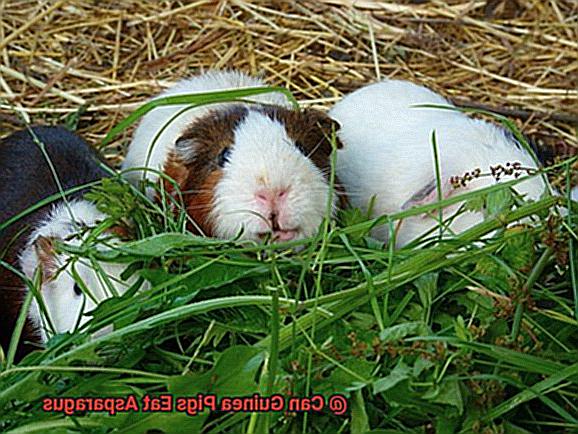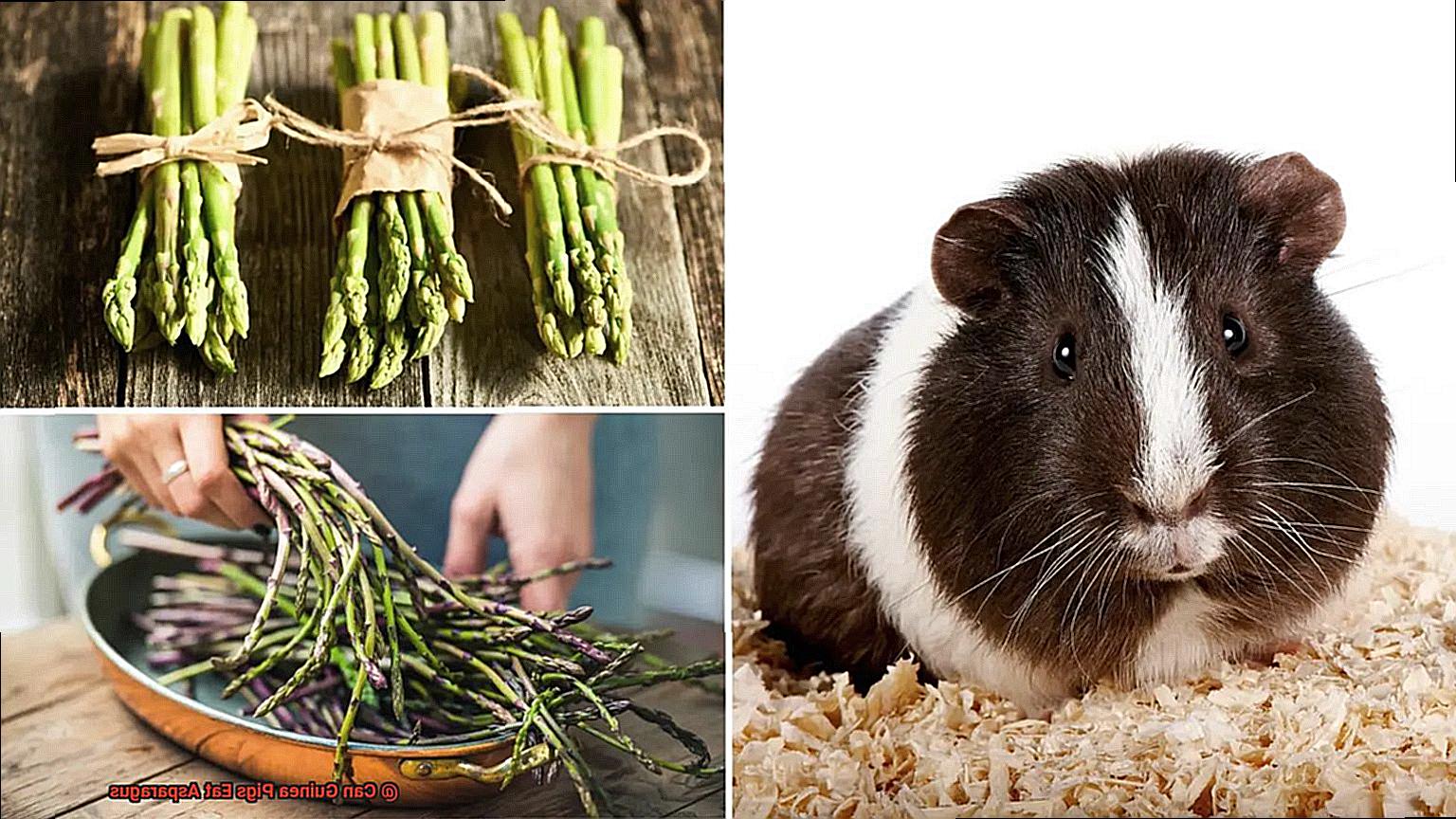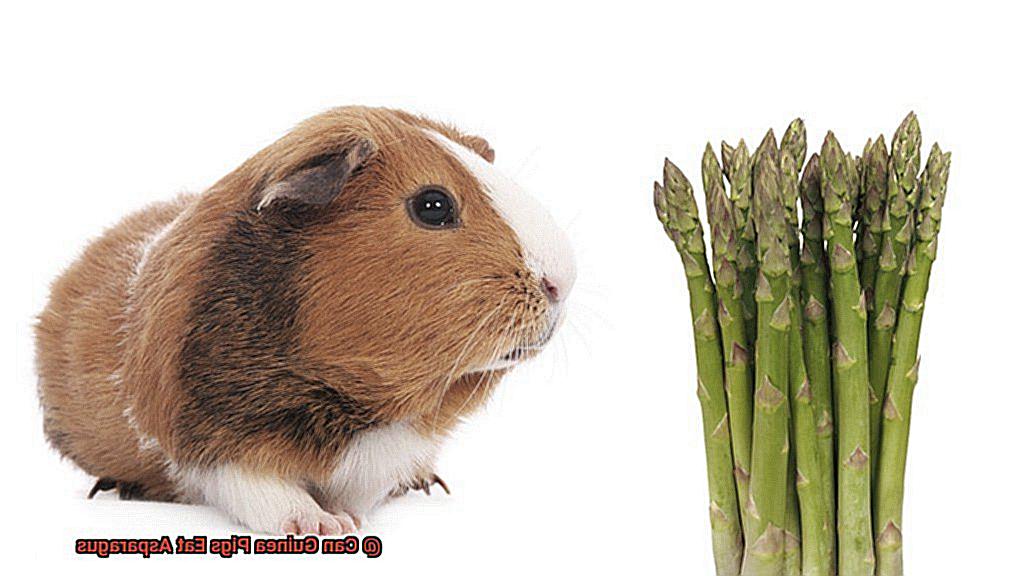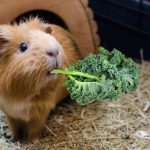Can guinea pigs eat asparagus? The answer is yes, but with a few key caveats. Asparagus can provide essential vitamins and minerals for your guinea pig.
But it’s important to limit the amount you give them, as too much can be dangerous. In this blog post, we’ll explore the nutritional benefits and drawbacks of asparagus for guinea pigs.
We’ll also look at how much you should feed your pet, and other things to keep in mind when feeding them this vegetable. First off, let’s talk about the vitamins and minerals that asparagus contains.
It has Vitamin C, Vitamin K, folate, iron, magnesium and potassium – all of which are beneficial to guinea pigs. So providing your pet small amounts of asparagus can help them stay healthy and strong.
However, there are some potential dangers associated with giving too much asparagus to your guinea pig. Asparagus is a form of oxalic acid which can be toxic in large amounts; plus it may cause choking or intestinal blockage if not handled properly.
So if guinea pigs can safely eat this vegetable, it’s important to remember that they should only have small amounts of it – use it as a treat or supplement rather than a regular part of their diet.
Nutritional Benefits of Asparagus for Guinea Pigs
Contents
Asparagus is packed with essential vitamins and minerals, making it an excellent addition to your guinea pig’s diet.
Here’s what you need to know about the nutritional benefits of asparagus for guinea pigs. Asparagus is high in vitamin C, which is vital for preventing scurvy in guinea pigs.

Additionally, it contains vitamin K, vitamin A, and folate – all of which are essential for guinea pig health. Furthermore, asparagus is a great source of fiber and low in calories – perfect for weight-conscious piggies.
However, it is important to remember that asparagus should be given to your guinea pig in moderation. Too much asparagus can lead to gas and bloating in guinea pigs, resulting in uncomfortable digestive issues.
It’s best to introduce asparagus slowly into their diet and monitor their reactions closely. When buying asparagus for your guinea pig, make sure you purchase organic or washed the asparagus thoroughly before serving it.
Guinea pigs are vulnerable to pesticides, so you’ll want to ensure the asparagus is free of any harmful chemicals before giving it to them. In summary, asparagus can be a healthy and tasty snack for your guinea pig if fed with care and moderation.
Its high vitamin content along with its low calorie and calcium content make it an ideal addition to their diet.
How to Feed Asparagus to Guinea Pigs
Asparagus is a nutritious and delicious snack that guinea pigs will love. Not only is it rich in vitamins and minerals, but it can also be prepared in a variety of ways. Here are some tips on how to feed asparagus to your piggies in the most safe and tasty way.
When buying asparagus, make sure it is organic and free of pesticides. Once you have the asparagus, wash it thoroughly before serving. Then, cut the asparagus into small pieces that are easy for your guinea pigs to eat.
You can serve the asparagus either raw or cooked. If you choose to cook it, boiling or steaming is best because these methods preserve the nutrients and are easier for your piggies to digest. Avoid adding any seasoning or salt to the cooked asparagus, as these can be harmful to their health.
It’s important to introduce asparagus slowly and in small amounts so that your guinea pigs don’t get an upset stomach. Start by giving them one spear per week and monitor their reaction closely. If they seem fine with it, you can gradually increase their servings of asparagus over time.
Remember that while asparagus is safe for guinea pigs in moderation, it should not replace their regular diet of hay, fresh vegetables, and pellets.
What Parts of the Asparagus are Safe for Guinea Pigs?

Asparagus can be a delicious and nutritious snack for your guinea pigs, but it’s important to know which parts of the plant are safe for them to eat.
While the tender tips of asparagus are fine for your furry friends, the woody stem and fibrous parts should be avoided. When preparing asparagus for your guinea pigs, make sure to thoroughly wash it and cut off any parts that are too tough or fibrous.

The tender tips can be offered raw, steamed, or boiled. It’s important to introduce new foods to your guinea pig’s diet slowly in order to avoid any potential digestive issues.
Asparagus is high in fiber and contains essential vitamins and minerals that are beneficial for your guinea pig’s overall health, so it can be a healthy addition to their diet when fed in moderation. However, fresh hay and fresh water should never be the only source of nutrition in their diet, and should always be supplemented with other fresh foods and hay.
How Much Asparagus Should I Feed My Guinea Pig?
Eating too much asparagus can cause digestive issues such as diarrhea, bloating, and stomach upset. So how much should you offer your cavy?
It is recommended to feed your guinea pig no more than an ounce or two of asparagus per serving. This amount should only be offered occasionally, not as an everyday staple.
To ensure the health of your pet, a balanced diet of hay, fresh vegetables, and pellets is essential. Asparagus is rich in fiber which is beneficial to their health, but it can also contain high levels of oxalates if consumed in excess.
Therefore, it’s important to maintain moderation when feeding them this vegetable – stick to one or two ounces per serving and only offer it occasionally. It’s also important to remember that guinea pigs have their own taste preferences.
To sum up, offering your guinea pig asparagus in moderation can provide them with a nutritious snack without worrying about any digestive problems.
Potential Health Risks of Eating Too Much Asparagus
Asparagus can be a hit with your furry friend, however, it should be consumed in moderation. Eating too much asparagus can lead to serious health risks.

Oxalates are found in high concentrations in asparagus and must be monitored by guinea pigs just like humans. If left untreated, consuming too much of this vegetable can result in painful kidney stones that may cause long-term health issues or even death.
Asparagus also contains high levels of fiber which aids digestion; however, overfeeding this veggie may cause digestive problems such as diarrhea or an upset stomach. Therefore, although guinea pigs may enjoy asparagus every now and then, it is essential not to overindulge them with this delectable dish.
Other Foods that Go Well with Asparagus for Guinea Pigs
Your guinea pig’s diet is essential to their overall health and wellbeing, so it is important to feed them a variety of vegetables.
Asparagus is a great option because it contains many vitamins and minerals, but should be offered in moderation to avoid digestive issues. But what other vegetables can you give your furry friend?
There are plenty of delicious and nutritious vegetables that pair perfectly with asparagus. Broccoli, zucchini, green beans, cauliflower, Brussel sprouts, cabbage, spinach, and bok choy are all excellent options for providing your guinea pig with the necessary vitamins and minerals.
Including a variety of vegetables in your guinea pig’s diet will ensure they get the nutrients they need for optimal health.
How to Prepare and Store Asparagus for Guinea Pigs
Asparagus is a healthy and delicious vegetable that can be an excellent addition to your guinea pig’s diet. Not only is it low in calories, but it also contains various vitamins and minerals that are beneficial for guinea pigs.
However, in order to ensure the safety and health of your furry friend, it is important to know how to prepare and store asparagus properly. Here are some tips on how to prepare and store asparagus for guinea pigs.
Purchasing Asparagus
When buying asparagus, make sure you look for firm, shiny green stalks with tightly closed tips. Avoid wilted or yellowing stalks as they are past their prime and lack nutritional value. It is also recommended to purchase organic asparagus or wash the stalks thoroughly before feeding them to your guinea pig in order to remove any pesticides that may be present on the stalks.
Preparing Asparagus
Before offering them to your guinea pig, you will need to clean and prepare the stalks by cutting off their woody ends with a sharp knife and rinsing them under cold running water if necessary. The asparagus can be served raw or cooked; blanching the pieces in boiling water for 3-5 minutes followed by an ice bath is a great way to prepare them without sacrificing their flavor or nutritional value.
Storing Asparagus
Any leftover asparagus should be stored in an airtight container in the refrigerator for up to three days in order to maintain its freshness and nutritional value. Do not store it in the refrigerator for longer than this time period if it has become wilted and lost its flavor and nutrients.
Serving Asparagus
When serving asparagus to your guinea pig, always remember that due its high oxalate content, this vegetable can cause bladder stones and other health issues if consumed in large quantities so only provide small amounts of cooked or raw asparagus occasionally as part of a balanced diet.
If your guinea pig experiences any digestive issues after eating this food, please consult a veterinarian right away to rule out any underlying health concerns.
PCDWC84eeHY” >
Tips for Introducing New Foods into Your Guinea Pig’s Diet
Introducing new foods into your guinea pig’s diet can be a tricky task, but it is essential to keep their diet varied and healthy. Here are nine tips to help you introduce new foods to your guinea pig:
Begin with Small Amounts
Start by offering your guinea pig a small, bite-sized piece of the new food. This will help you determine if they like it and if it agrees with their digestive system.
Introduce One Food at a Time
Avoid introducing too many new foods at once as this can upset their sensitive digestive system. Wait for at least three days before introducing another new food.
Choose Nutritious Foods
Select nutritious foods that are safe for guinea pigs, such as fresh vegetables, fruits, and hay.
Offer Variety in Their Diet
Guinea pigs love variety in their diet, so offer them different kinds of food and rotate them on a regular basis. This will ensure that they are getting all the nutrients they need while keeping mealtime interesting for your pet.
Avoid Sudden Diet Changes
Sudden changes in their diet can cause an upset in their digestive system, so make sure to introduce changes gradually over time.
Know What Foods to Avoid
Do not give your guinea pig foods that are toxic to them such as chocolate, caffeine, seeds, and certain vegetables; research these foods first and avoid them completely.
Wash Fruits and Vegetables Thoroughly
Always wash the fruits and vegetables before feeding them to your guinea pig; this helps remove any pesticides or harmful bacteria that may be present in the produce you buy from the store or market.
Remove Unconsumed Food Promptly
Any uneaten food within 24 hours should be removed from their cage as this can attract insects and cause gastrointestinal issues for your pet if left unattended for too long.
Monitor Your Guinea Pig’s Digestive Health
If you notice any changes in your guinea pig’s behavior or stool after introducing a new food, consult with your veterinarian right away.
By following these tips, you can help ensure that your guinea pig’s diet is varied and healthy while minimizing any potential digestive issues that may arise from introducing new foods into their diet.
Conclusion
In conclusion, asparagus can be a nutritious addition to your guinea pig’s diet – if treated with care and moderation.
It’s packed with essential vitamins and minerals that are beneficial for their overall health, but should only be given in small amounts to prevent digestive issues. When buying asparagus for your guinea pig, look for long, shiny green stalks with tightly closed tips – preferably organic or washed thoroughly.
Asparagus can be served raw or cooked; blanching the pieces in boiling water followed by an ice bath is a great way to prepare them without sacrificing taste or nutrition. Introduce new foods into your guinea pig’s diet slowly and carefully.
If they seem to enjoy it, you can gradually increase the servings of asparagus over time.






